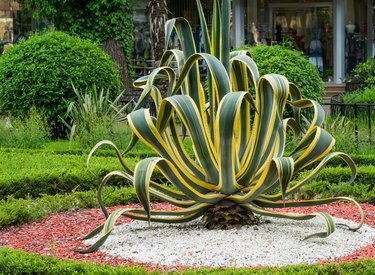
The aloes (Aloe spp.) range from the frost-tender true aloe (Aloe vera) to hardier South African natives like the torch plant (Aloe aristata), which thrive on your windowsill or outside in U.S. Department of Agriculture plant hardiness zones 7 through 12, depending on the species. While commonly grown in the kitchen window and relatively easy to grow, you may find pests, including fruit flies, on an aloe vera plant. First, determine what kind of flying bugs are infesting your aloe, then treat your plant appropriately.
About Aloe Plants
Video of the Day
The aloes are a group of approximately 500 succulent species in the family Asphodelaceae, primarily from the Mediterranean, Arabian peninsula, Madagascar and Africa. While the torch plant is hardy in USDA zones 7 through 10, the familiar aloe vera prefers the warmer climate of USDA zones 10 through 12. You can grow aloe vera outside in sheltered microclimates in USDA zone 9, as long as you protect it from frost and freezing temperatures.
Video of the Day
When growing an aloe in your kitchen window, take care to avoid overwatering. Like other succulents native to arid and desert climates, aloe prefers a well-drained soil and infrequent deep watering rather than a consistently moist soil.
Fruit Flies on an Aloe Vera Plant

Fruit flies (Drosophila spp.) are attracted to overripe fruit and decaying or fermenting organic matter. If your aloe has been damaged or overwatered, it may be attracting fruit flies. Remove broken or decaying leaves with pruners sterilized in Lysol. Keep the leaves dry until the cut ends have scabbed over to avoid attracting more fruit flies.
Consider adding a fruit fly trap to your windowsill. A jelly or fruit jar filled with 1/2 cup of stale beer and covered with a plastic bag secured by a rubber band will attract the flying pests. Snip 1/16 to 1/8 inch from the corner of the bag with scissors, then arrange it with the trimmed corner so it extends into the jar, like a funnel. The fruit flies crawl in seeking the fermenting beer, but won't find their way out.
Fungus Gnats in the Soil
Fuzzy gray flies fluttering above the soil are usually fungus gnats (Bradysia spp.). The larvae thrive in damp soil; your aloe is being overwatered. To eliminate fungus gnats, allow the soil in the flowerpot to dry out before resuming watering. Aloes can withstand drier conditions, so let the soil go completely dry.
When you water your aloe again, mix 1 part of 3 percent hydrogen peroxide with 4 parts water. Soak the soil with the solution to eliminate the eggs, larvae and any surviving gnats. Allow the soil to go nearly dry before repeating the treatment.
In severe cases, repot the aloe. Rinse the roots and trim off any decayed portions before setting the plant aside for two or three days so the cut ends can scab over. Replant in barely moist, fresh potting soil.
Whiteflies on the Leaves
Whiteflies (family Aleyrodidae) are tiny sap-sucking insects that infest new and soft growth on a variety of plants. If you tap on a leaf and a cloud of tiny white flies on the aloe plant appear, you have a whitefly infestation. The tiny whitefly eggs and larvae are found underneath leaves on infected plants.

Try taking your aloe and other houseplants to a shady location outside, and blast the leaves with plain water. Alternately, spray the plants with a solution of 2 to 5 tablespoons dishwashing liquid mixed with 1 gallon water to eliminate the tiny pests. Test a leaf first and wait a day to see if the solution affects the plant. Then treat all the plants at the same time to prevent the pests from moving from one plant to another.
To monitor for whiteflies and other flying insects, mount yellow index cards on bamboo stakes. Coat the cards with a mixture of equal parts petroleum jelly and dishwashing liquid to trap the pests. Push the stakes into the potting soil; the whiteflies will stick to the solution, making it easy to dispose of them in the trash.